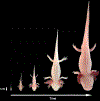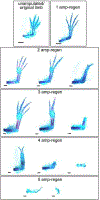Advancements to the Axolotl Model for Regeneration and Aging
- PMID: 31779024
- PMCID: PMC7214127
- DOI: 10.1159/000504294
Advancements to the Axolotl Model for Regeneration and Aging
Abstract
Loss of regenerative capacity is a normal part of aging. However, some organisms, such as the Mexican axolotl, retain striking regenerative capacity throughout their lives. Moreover, the development of age-related diseases is rare in this organism. In this review, we will explore how axolotls are used as a model system to study regenerative processes, the exciting new technological advancements now available for this model, and how we can apply the lessons we learn from studying regeneration in the axolotl to understand, and potentially treat, age-related decline in humans.
Keywords: Aging; Axolotl; Cancer; Immune system; Nerve signaling; Regeneration; Scar formation; Technological advances.
© 2019 S. Karger AG, Basel.
Conflict of interest statement
Disclosure Statement
The authors have no conflicts of interest to declare.
Figures




References
Publication types
MeSH terms
Grants and funding
LinkOut - more resources
Full Text Sources
Medical

